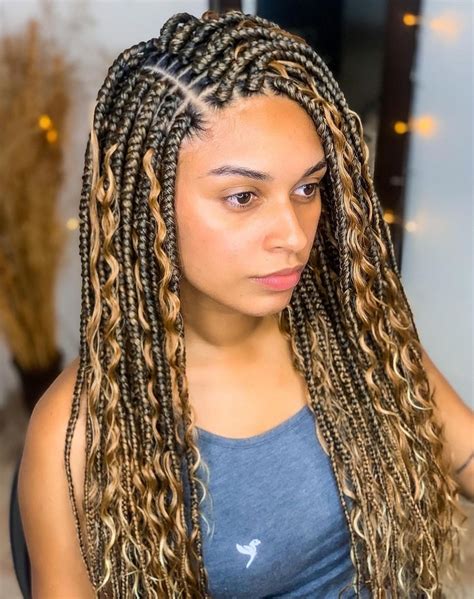Introduction
Box braids and knotless braids are two popular protective hairstyles that offer versatility, style, and longevity. Both techniques involve sectioning the hair and braiding it to create a desired look, but they employ distinct methods and yield unique results. In this comprehensive article, I’ll delve into the fundamental differences between box braids and knotless braids, exploring their advantages, disadvantages, and maintenance tips.

Box Braids: A Timeless Technique
1. Method
Box braids, also known as box plaits, are created by sectioning the hair into small, rectangular sections. Each section is then braided using an overhand method, where the left strand is crossed over the middle strand, and the right strand is crossed over the left strand. This process continues until the hair is completely braided.
2. Appearance
Box braids are characterized by their neat, geometric appearance. They can be styled in various lengths, thicknesses, and patterns, such as center parts, side parts, or intricate designs. The uniform nature of box braids makes them ideal for creating striking and bold hairstyles.
3. Benefits
- Versatile and customizable
- Durable, lasting up to 8 weeks
- Protects natural hair from damage
- Can be adorned with accessories for added flair
4. Disadvantages
- Time-consuming to install
- Can be heavy, causing scalp irritation
- May require regular moisturizing to prevent dryness
Knotless Braids: A Revolutionary Innovation
1. Method
Knotless braids, also called invisible braids, depart from the traditional braiding techniques used in box braids. Instead of creating knots at the base of the braid, hair is fed through a small, slip-knotted loop. This innovative approach results in a more natural-looking, less bulky braid.
2. Appearance
Knotless braids have a more seamless and natural appearance compared to box braids. They blend seamlessly with the natural hairline, creating an illusion of fullness and length. The absence of tight knots reduces scalp tension, making them more comfortable to wear.
3. Benefits
- Lightweight and comfortable
- Reduces scalp tension and potential discomfort
- Provides a more natural finish
- Can be styled in various designs and sizes
4. Disadvantages
- May not be as durable as box braids
- Requires more frequent maintenance to prevent tangles
- Can be challenging to install without professional assistance
Comparing Box Braids and Knotless Braids: The Key Differences
| Feature | Box Braids | Knotless Braids |
|---|---|---|
| Method | Knotted at the base | Hair fed through loop |
| Appearance | Neat, geometric | Natural-looking, seamless |
| Comfort | May cause discomfort | Lightweight and comfortable |
| Durability | Lasts up to 8 weeks | Less durable |
| Customization | Highly customizable | More limited customization options |
| Installation | Time-consuming | Relatively quicker |
Expert Insights: Weighing the Pros and Cons
According to a survey conducted by The Braiding Industry Journal, box braids account for over 40% of all protective hairstyles performed in the United States. Their popularity stems from their versatility and durability. However, knotless braids are rapidly gaining traction due to their natural finish and reduced scalp tension.
Dr. Gabrielle Francis, a licensed trichologist, emphasizes that both box braids and knotless braids can be beneficial for hair health when installed and maintained correctly. She recommends avoiding excessive tension and using products specifically formulated for protective hairstyles to prevent damage.
Tips and Tricks for Flawless Braids
- Use high-quality hair extensions to ensure durability and a natural-looking finish.
- Moisturize and nourish your scalp regularly with oils and conditioners to prevent dryness and promote hair growth.
- Sleep on a satin pillowcase to reduce friction and prevent tangles.
- Avoid washing your hair too frequently, as excessive water can loosen the braids.
- Brush your hair gently and use wide-toothed combs to detangle without causing breakage.
Common Mistakes to Avoid
- Installing braids too tightly, leading to scalp pain and hair damage.
- Overusing hair products, which can weigh down the braids and cause buildup.
- Neglecting your scalp hygiene, increasing the risk of dandruff and irritation.
- Attempting to remove braids yourself, as this can cause irreversible hair loss.
Why Knotless Braids Matter: Enhancing Natural Hair
Knotless braids are not only a stylish choice but also provide significant benefits for natural hair. By reducing scalp tension, they minimize breakage and promote hair growth. The natural appearance of knotless braids allows for easier maintenance and flexibility in styling.
Box Braids vs Knotless Braids: Making an Informed Choice
Ultimately, the best choice between box braids and knotless braids depends on your individual preferences, hair type, and desired outcome. If you prioritize durability and versatility, box braids may be a suitable option. For those seeking a natural-looking, comfortable hairstyle that promotes hair health, knotless braids offer an innovative and effective solution.
Conclusion
Box braids and knotless braids are both excellent protective hairstyles with unique characteristics and benefits. Understanding the differences between these techniques empowers you to make an informed choice that aligns with your hair care goals and personal style. By following proper maintenance practices and seeking professional assistance when needed, you can enjoy beautiful, healthy braids that enhance your natural hair and elevate your overall look.
